- Author: Kathy Keatley Garvey
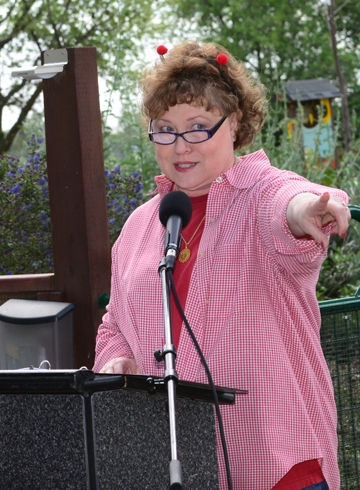
The honey bee garden owned and maintained by the UC Davis Department of Entomology and Nematology has received a $15,000 donation from the California State Society of the Daughters of the American Revolution.
State Regent Debra Jamison of Fresno, as part of her two-year fundraising project to support the troubled bee population, donated the funds to enhance the bee environment in the Häagen-Dazs Honey Bee Haven, a half-acre bee friendly garden located next to the Harry H. Laidlaw Jr. Honey Bee Research Facility on Bee Biology Road.
Jamison, the 2012-2014 state regent, presented the check March 28 at a “lunch-with-the-bees” celebration organized by the UC Davis College of Agricultural and Environmental Sciences. Some 125 DAR members, some from as far away as Chico and San Diego, dined beneath a canopy of olive trees bordering the road.
“We appreciate this more than we can say,” said Ed Lewis, professor and vice chair of the department--and whose mother belongs to DAR.
This was DAR's second check presentation in two years to the UC Davis Department of Entomology and Nematology. In 2013, Jamison presented a check for $30,000 for bee research to assistant professor Brian Johnson.
On behalf of the department, haven manager Christine Casey accepted the $15,000 check from Jamison and Karen Montgomery of Modesto, the state regent's project chair. Casey announced that some of the funds have already been used to purchase two benches, and other projects will include a shade structure in the Growers Grove section and more bee habitat.

Jamison adopted the motto, “Bees are at the heart of our existence” and vowed to support honey bee research and enhance honey bee environments to help the beleaguered bees.
Honey bees prefaced the American Revolutionary War (1765-1783) by 143 years. European colonists brought the honey bee to Jamestown colony, Virginia, in 1622. Descendants of the American Revolutionary War formed DAR in 1890.
“When the state regent's project was conceived, I never imagined that honey bees would be in the serious state they are in,” Jamison told the luncheon crowd. “I could not have imagined that this amazing insect would make the cover of Time magazine, or that the California DAR would be involved in trying to do something to help the most vital insect in the animal kingdom.”
“Our 114 chapters and 15 districts have worked diligently to educate members, children, and the public about the plight of bees,” Jamison said. “This outreach has been truly outstanding. Add to that the phenomenal fundraising efforts. I truly thought that when I brought this project before the members that they might think, ‘Eeeeeuuuu, creepy insect, and weird state regent.'
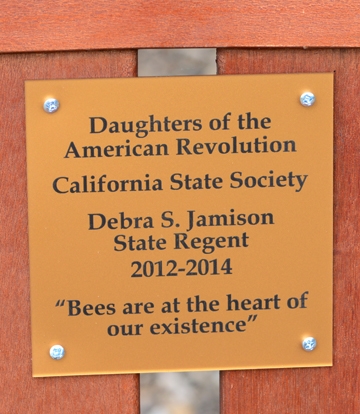
Jamison presented certificates of appreciation to Extension apiculturist Eric Mussen and communication specialist Kathy Keatley Garvey of the UC Davis Department of Entomology and Nematology for their work in helping DAR with the two-year project.
“Kathy is the first live body I talked to about a possible project at UC Davis,” Jamison said. “She was immediately excited and hooked me up with the resident researcher here at the time. Our members know that Kathy is an accomplished micro-photographer, and they have seen many of Kathy's photos because she has been so open to sharing them with our organization. We also thank her for publicizing the first phase of this project. Our members were so excited to read all about it on the internet!”
Next, she paid tribute to Extension apiculturist Eric Mussen, a member of the faculty since 1976. “Dr. Mussen, there is no way we could have put this project together without you and all of the information you provided,” she told him. “Your willingness to meet with me, and to give a tour of the lab and Honey Bee Haven was so appreciated and so kind of you. Thank you for answering all of my questions and emails over the last two years.”
“A little bee at the Central Valley Beekeepers Association--of which I am now a member-- told me you would be retiring this summer. My best wishes for a happy retirement and more personal time to spend with your bees!”
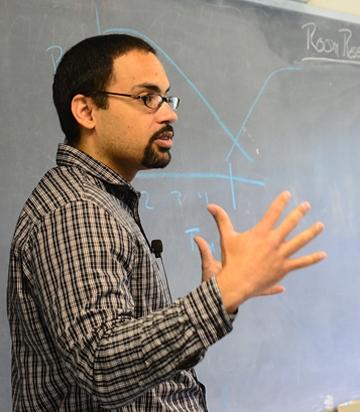
"Bee Patriotic” rally towels decorated each table. Last year Jamison's rally towels were lettered with “Bee-lieve in the Power of DAR."
All those attending the March 28th luncheon received a “I Beelong to DAR” recyclable grocery bag.
The crowd toured the haven, which was installed in the fall of 2009, and ended the day with bee presentations in the Laidlaw facility conference room.
Mussen talked about the life cycle of bees and the issues bees face: malnutrition, pesticides, pests, parasites, diseases and stress. Malnutrition, Mussen said, is a bigger problem now than colony collapse disorder (CCD), a mysterious malady characterized by adult bees abandoning the hive. An active colony of honey bees requires an acre-equivalent of mixed blooms, daily, to meet their nutritional needs.
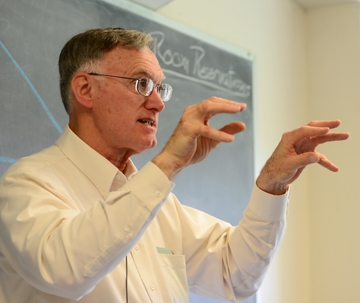
Mussen also warned that simply because certain pesticides are labeled for use in organic gardening does not mean that they are less dangerous for non-target insects, particularly pollinators. Also, insecticides that are watered into the soil and move from the roots, systemically throughout the plants, are secreted in the nectar and pollens when the treated plants bloom.
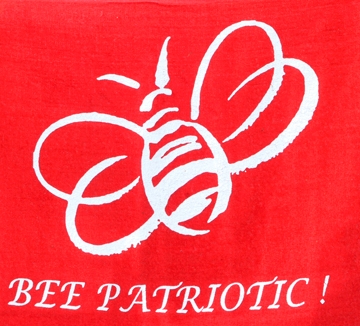
Johnson thanked DAR for the generous donation of $30,000 that he received last year. He said the financial support will cover a two-year period of graduate student research. His graduate student, Gerard Smith, researches the effect of pesticide exposure in the field on honey bee foraging behavior, and graduate student Cameron Jasper studies the genetic basis of division of labor in honey bees.

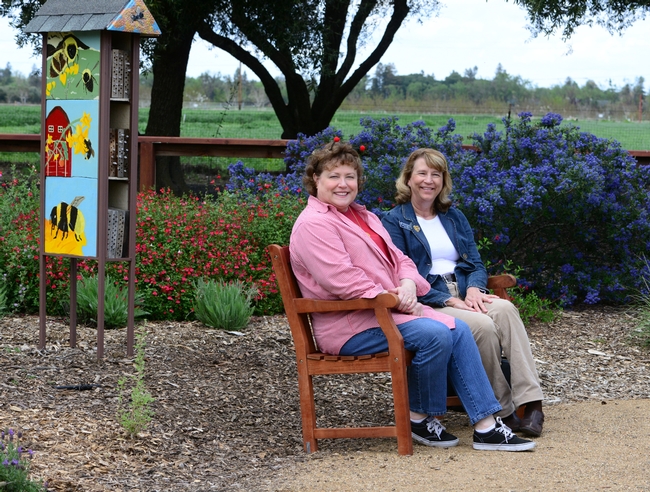
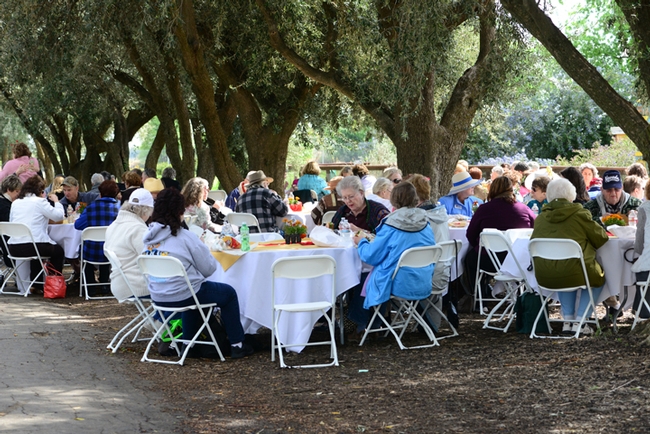
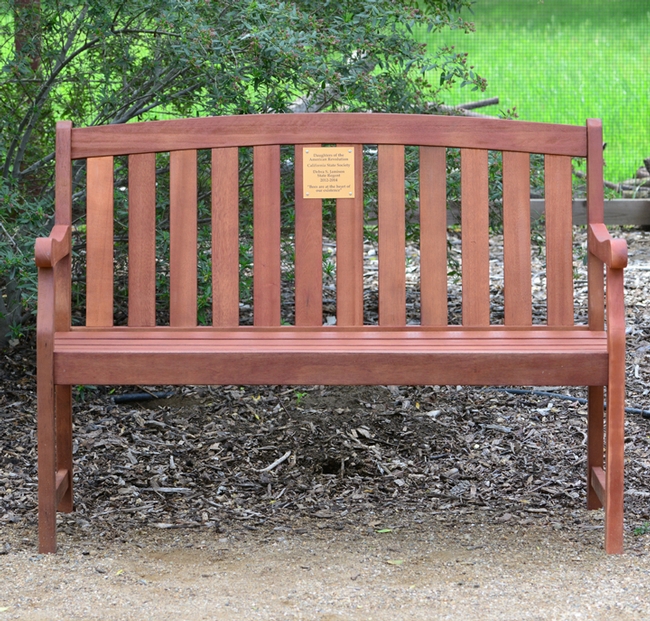
- Author: Kathy Keatley Garvey
Profile
Orchard Alley at the Häagen-Dazs Honey Bee Haven is getting a much-needed pruning.
Professional tree pruner Andrew "Andy" Ross, staff research associate for nematology and the safety coordinator for the Department of Plant Pathology and the nematology portion of the UC Davis Department of Entomology and Nematology, began pruning the almond, plum and apple trees this morning (Nov. 1).
Ross joined the UC Davis workforce in January in 2005 after managing a citrus/avocado/olive ranch in Porterville for 20 years.
“I started pruning trees right out of high school, working in a private redwood grove in 1986,” he said.
Ross received his bachelor's degree in biological sciences from UC Davis in 2007, with a minor in chemistry.
As the lab manager for nematologist Ed Lewis, professor and vice chair of the UC Davis Department of Entomology and Nematology, Ross guides the nematology lab members, including graduate and undergraduate students and technicians.
Before becoming manager of the Porterville ranch, Ross planted trees from December through May of 1987 in the Deep South for a private company, Evergreen Forestry Services, based in Sandpoint, Idaho.
He and his wife, Monica Ross, executive assistant to Jay Speck, Superintendent of Solano County Schools, are working on renovating their 1936 home in Dixon. They have two daughters, who both received college degrees in sociology. The Rosses are also grandparents: a three-year-old and a three-month-old.
The Department of Entomology and Nematology is planning a volunteer work day on Saturday, Nov. 2, organized by haven coordinator Christine Casey and chief administrative officer Janet Brown-Simmons. Sign up on Doodle at http://doodle.com/txnz3vg293vznvyh, or contact Casey at cacasey@ucdavis.edu or Simmons at jbs@ucdavis.edu for more information.
The haven is located on Bee Biology Road, next to the Harry H. Laidlaw Jr. Honey Bee Research Facility,west of the central campus.
-----------------------------------------------------------------------------------------------------------------------------------
What to Bring
Thanks to everyone who has volunteered for tomorrow's work day at the Honey Bee Haven garden. A few last minute reminders….
- Please bring gloves, hats, and sunscreen. We have a few pairs of gloves to loan if you do not have your own. Also, please wear closed-toe shoes and avoid using heavily scented personal care products.
- We could use extra pruning shears, so again if you have your own please bring them.
- We will provide food and drinks. For the morning crew, I will have coffee at the garden by 7:30.
- If you've never been to the garden, we are located just east of the Laidlaw research facility on Bee Biology Road: http://campusmap.ucdavis.edu/?b=77
- Please plan on arriving five minutes prior to the start of your shift. We'll review your work assignments, do a brief training for those less-experienced gardeners and then pair you with someone with more experience if possible.
Chris Casey, cacasey@ucdavis.edu
Manager,
Häagen-Dazs Honey Bee Haven


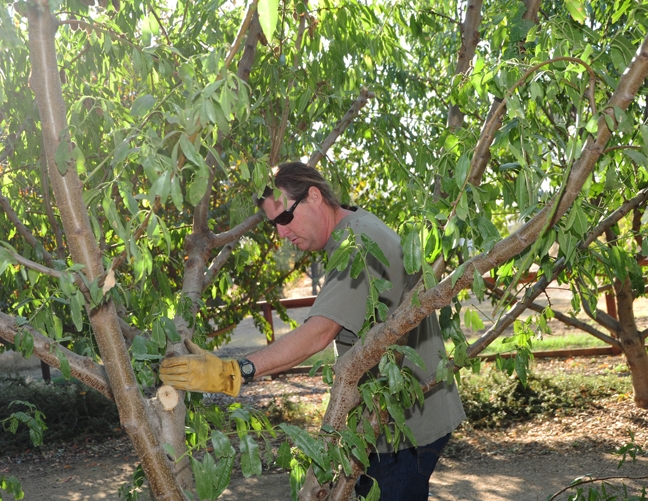

- Author: Kathy Keatley Garvey
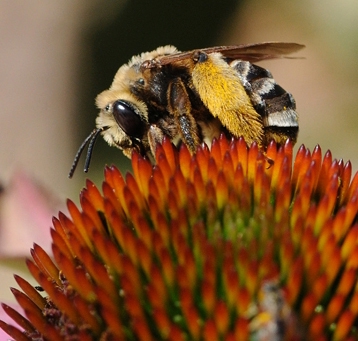
The garden, planted in the fall of 2009, is located on Bee Biology Road, next to the Harry H. Laidlaw Jr. Honey Bee Research Facility.
Kimsey was singled out for her work when the Pacific Branch of the Entomological Society of America honored her and four others--"The Bee Team"--with the 2013 outstanding team award.
A Sausalito team--landscape architects Donald Sibbett and Ann F. Baker, interpretative planner Jessica Brainard and exhibit designer Chika Kurotaki--won the design competition.
The judges were Professor Kimsey; founding garden manager Missy Borel (now Missy Borel Gable), then of the Califoria Center for Urban Horticulture; David Fujino, executive director, California Center for Urban Horticulture at UC Davis; Aaron Majors, construction department manager, Cagwin & Dorward Landscape Contractors, based in Novato; Diane McIntyre, senior public relations manager, Häagen-Dazs ice cream; Heath Schenker, professor of environmental design, UC Davis; Jacob Voit, sustainability manager and construction project manager, Cagwin and Dorward Landscape Contractors; and Kathy Keatley Garvey, communications specialist, UC Davis Department of Entomology.
Others who had a key role in the founding and "look" of the garden included the UC Davis Art/Science Fusion Program, founded and directed by the duo of entomologist/artist Diane Ullman, professor and former chair of the UC Davis Department of Entomology, and self-described "rock artist" Donna Billick. The art in the garden is the work of their students, ranging from those in Entomology 1 class to community residents. Eagle Scout Derek Tully planned, organized and built a state-of-the-art fence around the garden.
The timeline:
Feb. 19, 2008
Häagen-Dazs Donation to UC Davis
Dec. 8, 2008
Häagen-Dazs Launches Bee Garden Design Contest
Aug. 6, 2008
Insect Virus Researcher Michelle Flenniken Named Häagen-Dazs Postdoctoral Fellow at UC Davis
Feb. 26, 2009
Sausalito Team Wins Design Competition
Aug. 6, 2009
Haagen-Dazs Honey Bee Haven Site Preparation
Aug. 13, 2009
Bee Biology Website to Be Launched
Aug. 13, 2009
Thinking Outside the Box
Sept. 15, 2009
Campus Buzzway: Wildflowers
Dec. 15, 2009
Bee Biology Website Lauded
2010
June 6, 2010
Grand Opening Celebration of Honey Bee Garden
July 15, 2010
Art Is Where the Community Is; Blending Science with Art in the Häagen-Dazs Honey Bee Haven
July 30, 2010
More Than 50 Bee Species Found in Haven: Robbin Thorp (Now there's more than 80 and counting!)
Aug. 25, 2010
Donna Billick: Miss Bee Haven
Aug. 11, 2011
What the Signs Tell Us in the UC Davis Honey Bee Garden
Aug. 24, 2011
Royal Visit to Harry H. Laidlaw Jr. Honey Bee Research Facility
April 11, 2012
Brian Fishback: Spreading the Word about Honey Bees
Aug. 26, 2013
Eagle Scout Project: Fence Around the Bee Garden
Sept. 11 2012
A Fence to Behold
2013
April 25, 2013
UC Davis Bee Team Wins Major Award
Aug. 1, 2013
Häagen-Dazs Honey Bee Haven Place to Be
With photo of founding volunteers
Biographies
Eric Mussen
Retired Extension apiculturist, who continues his work
Robbin Thorp
Native pollinator specialist and emeritus professor of entomology who monitors the bees in the haven
Donors
List of Donors (2009 through July 2014)
For more information on the garden or to donate, see the Häagen-Dazs Honey Bee Haven website.
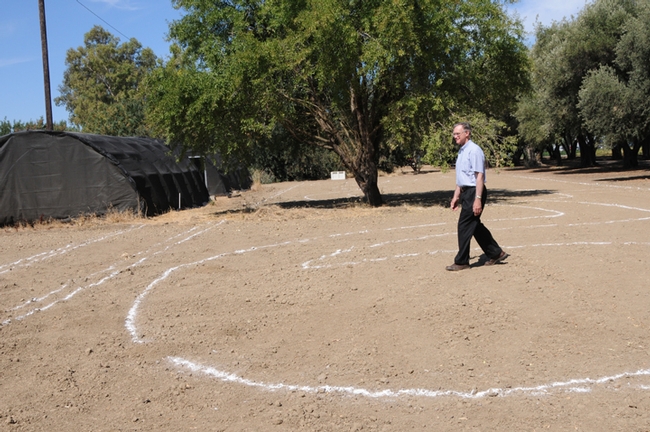

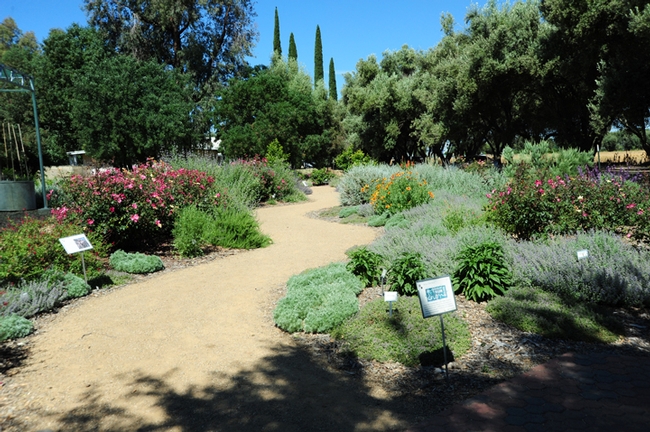
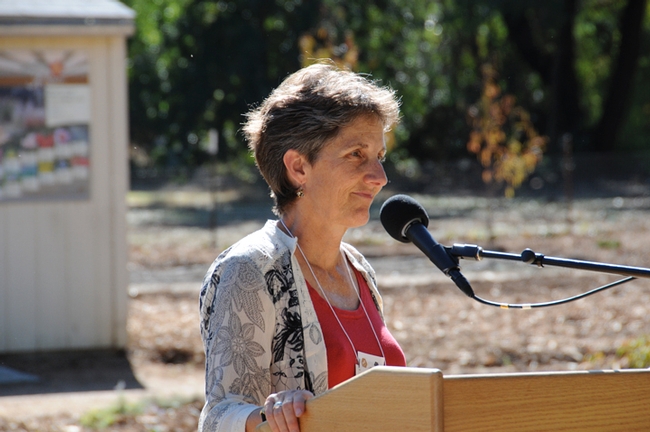
- Author: Kathy Keatley Garvey

The Häagen-Dazs Honey Bee Haven, a half-acre, bee-friendly garden planted in the fall of 2009 next to the Harry H. Laidlaw Jr. Honey Bee Research Facility on Bee Biology Road, UC Davis, is, in one word—spectacular.
Featuring a series of interconnected gardens with names like “Honeycomb Hideout,” “Nectar Nook” and “Pollinator Patch,” the garden provides the Laidlaw honey bees with a year-around food source, raises public awareness about the plight of honey bees, encourages visitors to plant bee-friendly gardens of their own, and serves as a research site.
Through its parent company Dreyer's Grand Ice Cream, Häagen-Dazs has gifted or pledged a total of $252,000 to the garden.
It's a gift to the UC Davis Department of Entomology but it's more than that. “It's a gift to the campus, the community and the honey bees and other pollinators that visit it,” said Extension apiculturist Eric Mussen of the entomology faculty.
“This garden is a living laboratory to educate, inspire and engage people of all ages in the serious work of helping to save honey bees,” said Dori Bailey, director of Haagen-Dazs Consumer Communications.
It offers bees and other pollinators “a place to thrive,” Bailey said, and “it contributes to finding answers that enable us to be better stewards of these tiny pollinators.”
The design? It's the brainchild of Sausalito-area landscape architects Donald Sibbett and Ann F. Baker; interpretative planner Jessica Brainard; and exhibit designer Chika Kurotaki, who teamed to win the international design competition.
Entomology professor Lynn Kimsey, who chaired the department in 2009 and helped judge the design competition, calls the haven “a campus destination.”
“It's the place to go, the place to be,” she said.
Depending on the season, the garden flourishes with fruits, vegetables, nuts and ornamentals, including almond, plum, apple, pomegranate, persimmon, strawberries, blueberries, watermelon, artichokes, onions, salvias, lavenders and daisies. All are labeled by common name and scientific name, in a project spearheaded by Melissa “Missy” Borel, program manager of the California Urban Center for Horticulture, who oversaw the development of the garden
Art graces the garden, thanks to the UC Davis Art/Science Fusion Program, founded and directed by entomologist-artist Diane Ullman and Davis-based artist Donna Billick. Billick sculpted the six-foot-long worker bee that anchors the haven. Students and area residents crafted the bee-motif ceramic tiles that line a bench, which also includes the names of major donors. The nearby shed is walled with ceramic tiles of native bees.
Volunteers from the Davis community tend the garden every Friday morning. Faculty, staff and students lead tours.
For native pollinator specialist Robbin Thorp, emeritus professor of entomology, the garden is a research site. He is monitoring the bee species foraging in the garden. “Just over 40 species of bees were found the first year since the garden was planted,” he said. “About half of these were new to the area based on my survey the year prior to planting. As the garden matures and perhaps some new plants are added, I expect the diversity of bees using it to increase.”
The garden is also global in nature. Due in part to Häagen-Dazs web-based marketing, more than 600 donors around the world have contributed more than $70,000 to support honey bee research. In all, what Häagen-Dazs has given to the UC Davis bee biology program exceeds $350,000—this includes funding for the Häagen-Dazs Postdoctoral Scholar and other projects.
The Bee Haven came to "bee" after officials at the Haagen-Dazs read a research news story on honey bees, written by communication specialist Kathy Keatley Garvey and telephoned her. The article, on "building a better bee," chronicled the plight of honey bees and the work of bee breeder-geneticist Susan Cobey, then manager of the Harry H. Laidlaw Jr. Honey Bee Research Facility and now with Washington State University. Haagen-Dazs served as the primary donor of the garden and also funded the Häagen-Dazs Postdoctoral Fellowship at UC Davis. It went to Michelle Flenniken, an insect virus researcher based at UC San Francisco. She is now a professor at Montana State University.
The design blueprint can be downloaded at http://beebiology.ucdavis.edu/HAVEN/honeybeehaven.html
Links:
Sausalito Team Wins Design Competition
http://ucanr.edu/blogs/blogcore/postdetail.cfm?postnum=15240
Grand Opening Celebration of Honey Bee Garden
http://ucanr.edu/blogs/blogcore/postdetail.cfm?postnum=15249
Eagle Scout Project: Fence Around the Bee Garden
http://ucanr.edu/blogs/blogcore/postdetail.cfm?postnum=10166
Campus Buzzway: Wildflowers
http://ucanr.edu/blogs/blogcore/postdetail.cfm?postnum=15242
Haagen-Dazs Honey Bee Haven: Sacramento Bee Award
(With photo of founding volunteers)
http://ucanr.edu/blogs/blogcore/postdetail.cfm?postnum=10205
Shedding Light on Native Bees
https://ucanr.edu/blogs/blogcore/postdetail.cfm?postnum=27570
- Author: Kathy Keatley Garvey
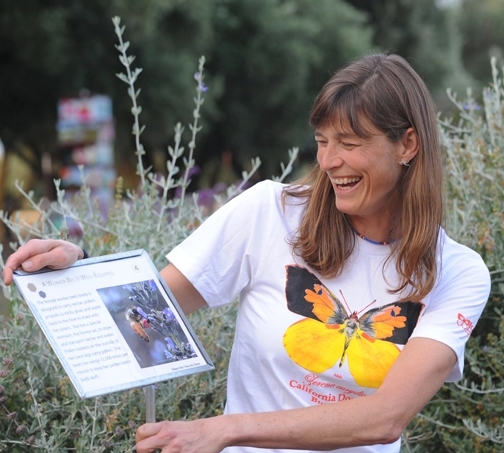
Veteran biology teacher Sarah Huber researched, created and installed two dozen illustrated signs, which provide a self-guided tour of the half-acre Häagen-Dazs Honey Bee Haven, located next to the Harry H. Laidlaw Jr. Honey Bee Research Facility on Bee Biology Road.
The haven is as a year-around food source for bees, a demonstration garden and a research site.
Huber described the bee garden as “an amazing resource for anyone designing their own garden, taking their kids on a new adventure, or just meeting a friend for a walk.”
The haven is “a lasting source of inspiration for the public,” she said.
The numbered signs welcome visitors to the garden, relate why bees are amazing, why they are in trouble, and what folks can do to help.
Visitors can learn why beekeepers don't eat bananas before they tend their hives (“A bee in danger releases an alarm pheromone which is also a chemical found in bananas”) how many flowers a colony must visit to make one pound of honey (“two million flowers”), and how fast a bee's wings can beat (“12,000 times a minute”).
Huber's signs also point out why the honey bee is considered both an immigrant and migrant worker. European colonists brought the honey bee (Apis mellifera) to America in 1662. Today U.S. farmers rent 2 million colonies a year to pollinate their crops.
“Some farmers own their own hives, but many rent hives from beekeepers to pollinate their crops,” Huber wrote. “Hives travel by truck from one flowering crop to the next each season. Smaller farms in less developed areas may rely on wild native bees and feral honey bees for pollination. However, each year more than 2 million bee colonies are rented for U.S. crop pollination.”
The signage begins with: “Follow the numbered signs to gain an appreciation for the amazing adaptations of honey bees and the invaluable services they provide. Experience empathy for their plight and be inspired to take action to help save them as their population declines.”
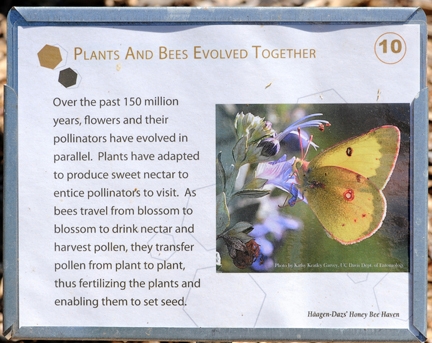
Huber launched the signage project after consulting with Tabatha Yang, education and outreach coordinator for the Bohart Museum of Entomology at UC Davis; Extension apiculturist Eric Mussen of the UC Davis Department of Entomology faculty; bee breeder-geneticist Susan Cobey of UC Davis and Washington State University; native pollinator specialist Robbin Thorp, emeritus professor of entomology at UC Davis, who monitors the garden for different species of bees; staff research associate-beekeeper and haven coordinator Elizabeth Frost of the Laidlaw facility; and communications specialist Kathy Keatley Garvey of the UC Davis Department of Entomology.
Garvey provided the photos for the signs, which include a feral honey bee colony, activities inside and outside the hive, and pollinator “portraits,” including such floral visitors as honey bees, bumble bees, carpenter bees, digger bees and butterflies.
“I am so glad that Tabatha gave me the project of designing a self-guided tour for the bee garden,” said Huber. “Using the signs seemed the most environmental and easy way to do this. I learned a lot about bees while researching what to put on each sign, as well as many cool tidbits of useful information, like how to build a nest site for native bees, and that it is best not to eat bananas when approaching a hive, just to name a couple.”
“Sarah is a fabulous educator,” Yang said. “We were incredibly fortunate to have her on our team. She is creative and fun and radiates enthusiasm for science education. It was an absolute pleasure to work with her.”
Huber also assisted with other outreach projects on the UC Davis campus, providing support for the Department of Entomology, the Bohart Museum of Entomology, and the Museum of Wildlife and Fish Biology (MWFB). In addition, she volunteered at the Explorit Science Center, Davis.
Huber joined the UC Davis volunteer workforce for a year while her husband, Parke Wilde, an associate professor at Tufts University, Boston, pursued academic work at UC Davis.
A former Peace Corps volunteer in Bolivia and El Salvador, Huber received her bachelor of science degree, cum laude, in biology from Carleton College in Northfield, Minn., and master's degree in secondary science education from Catholic University, Washington, DC. Huber's credentials include teaching interactive workshops for elementary-aged children and facilitating drop-in science, math and technology activities at the Museum of Science in Boston.
The garden is the work of scores of companies, people and volunteers. A four-member team from Sauslalito submitted the winning design in an international competition: landscape architects Donald Sibbett and Ann F. Baker; interpretative planner Jessica Brainard; and exhibit designer Chika Kurotaki.
“This garden is a living laboratory to educate, inspire and engage people of all ages in the serious work of helping to save honey bees,” Dori Bailey, former director of Haagen-Dazs Consumer Communications, said earlier this year. It offers bees and other pollinators “a place to thrive,” Bailey said, and “it contributes to finding answers that enable us to be better stewards of these tiny pollinators.”
Melissa “Missy” Borel, program manager of the California Urban Horticulture at UC Davis and a key developer of the garden under the watch of Bohart Museum of Entomology director Lynn Kimsey, then interim chair of the UC Davis Department of Entomology, posted plant identification signs so visitors can select what they might want to plant in their own gardens. A volunteer team of gardeners, headed by Mary Patterson of Davis and coordinated by Frost, tend the garden every week.
The garden also features art from the UC Davis Art/Science Fusion Program, co-founded and co-directed by UC Davis entomologist-artist Diane Ullman and Davis artist Donna Billick. “Miss Bee Haven,” a six-foot long sculpture of a worker bee by Billick, anchors the art work. Painted bee boxes, showing activity inside and outside a honey bee colony, grace the entrance. The most recent addition to the garden is a native bee mural on a garden shed, a project coordinated by UC Davis graduate student Sarah Dalrymple.
Ullman, Billick and Dalrymple are now consulting with Frost and Thorp on other art projects that will showcase native bees, particularly leafcutting bees.


